Disease and pests can take a serious toll on your plants. Using hydroponics to grow your plants can reduce many issues, but it is not immune to many common plant problems.
The most common problems in a hydroponic system are root rot, disease, and pests. Typically, these issues are prevented by adequate air circulation and water circulation. Adding simple fans and air stones can easily prevent the most common issues.
Fortunately, the most common problems facing your hydroponic garden can be fixed if caught soon enough without serious harm to your plants. Hydroponics is an excellent way to grow plants and has many benefits compared to growing plants in soil. Learn more about the benefits of growing with hydroponics in our article, Advantages of Using Hydroponics.
Root Rot in Hydroponics
Root rot is a common plant disease that causes the roots of your plant to decay. It is found in both hydroponic and soil plants, especially potted plants. It can spread to other plants if you don’t react quickly enough
Because roots are typically under the soil, it is hard to discover the roots are rotting until the disease has advanced in ways that make it obvious the plant is dying. And unfortunately, it is usually too late.
With hydroponics, the roots aren’t buried, so they’re easier to observe, as long as you’re paying attention. Checking on your plant’s root health frequently will help you monitor for this disease.
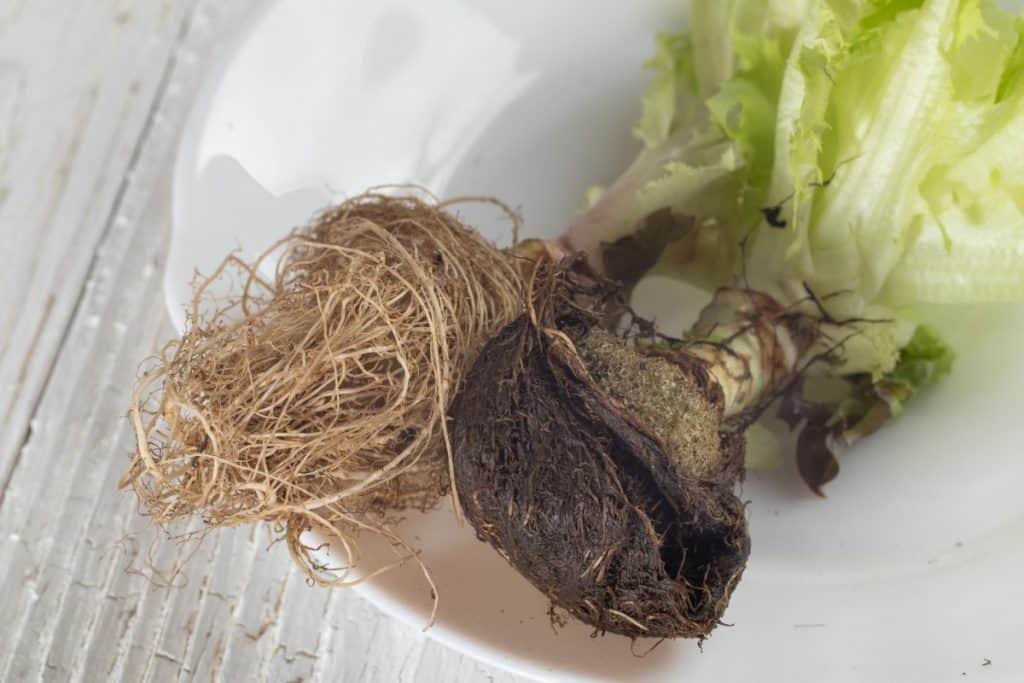
What Causes Root Rot?
Root Rot is caused by overwatering, poor drainage of damp soil and lack of oxygen. Root rot is particularly challenging in hydroponics, considering the roots are always underwater.
If the roots have enough oxygen then generally root rot is not an issue. But, if the roots aren’t getting enough oxygen through the hydroponic solution, or if part of the system isn’t functioning well enough to supply the roots with enough air, they’re susceptible to root rot. And the outcome usually isn’t good.
How Can You Tell if Your Hydroponic Plants Have Root Rot?
Usually, the first signs your plant is dealing with root rot is a droopy appearance and yellowing foliage. In hydroponic plants, you have access to see the roots growing because there isn’t any soil involved.
Healthy roots in hydroponics have a creamy white color. But as they start to decay and rot, the roots take on a browner color that may or may not have an odor to it.
The brownish color is a slime that prevents oxygen from reaching the roots, which will eventually kill the plant.
How to Save Your Hydroponic Plants with Root Rot
As long as you catch the root rot in the very early stages, there’s a possibility of saving your plants. Early intervention is exactly why it’s so important to check on the roots often. If the root rot is too far gone, there’s no hope of recovery.
These are the steps you can take to treat root rot:
- Remove the plant for the hydroponic setup, the container will need to be cleaned and sterilized to remove any bacteria
- Rinse the roots and trim any slimy, dead, and infected roots.
- Add 3mL of 29% hydrogen peroxide to your plant’s reservoir and let the plant’s roots sit in the solution for 24 hours.
- Drain the hydrogen peroxide solution and fill with plain freshwater, let your plant’s roots sit in the water for 24 hours
- Drain the fresh water and fill the container with appropriate nutrient solution
This should kill any bacteria that caused the root rot and hopefully let your plant recover. But that’s only IF your plant wasn’t too damaged by the root rot
Ways to Prevent Root Rot
Preventing root rot is much easier than treating it. You can prevent root rot by using beneficial bacteria, adding oxygen, reducing light to roots, keeping a moderate temperature, and ensuring proper water flow.
Beneficial Bacteria
Beneficial bacteria are extremely popular with hydroponic gardeners. These good bacterias will outperform the bad bacteria that cause root rot.
Simply add the correct amount of beneficial bacteria solution into your water. The two most popular brands are Hydroguard and Voodoo Juice.
| Preview | Product | |
|---|---|---|

|
Botanicare Hydroguard Bacillus Root Inoculant, Quart | View Latest Deal |
Increase Oxygen
One of the main causes of root rot is a lack of oxygen reaching your roots. Using a high quality air pump connected to air stones that go into the water generate bubbles of oxygen. This added oxygen will prevent the bad bacteria from growing and help your plant fight off those toxic pathogens that cause root rot.
- Steady Output: Max Air Flow Rate: 64 GPH; Pressure: 0.016 MPa; Power: 4 W. Perfect for aeration...
- Adjustable Air Flow: Feature a rotary knob to control the amount of air for dual outputs,...
- Quiet Operation: The pump emits 25 dB sound under the “Low” mode and maximum 45 dB noise...
Light Leaks
Roots hate light. Root Rot pathogens, however, love it. Whether it’s a simple towel or some carefully constructed water tub, blocking light from the roots will help prevent root rot.
Heat
Root rot loves a warm environment. But hydroponic plants grow best in water with temperatures between 60-75 degrees Fahrenheit.
Also, water has a harder time holding oxygen when warmer, so it is best to keep your hydroponic garden at room temperature.
Stagnant Water
The bacterias that cause root rot also thrive in standing water. If you are using a hydroponic method that doesn’t use any pumps like Kratky then changing the water and cleaning your container will help prevent root rot from starting.
Plant Diseases in Hydroponics
Root Rot isn’t the only disease that affects hydroponic plants. Unfortunately, there are plenty more diseases you need to look for when inspecting your plant.
Powdery mildew and gray mold are two of the most common amongst hydroponic gardens.
Powdery Mildew
Powdery mildew is a fungal disease that looks like someone sprinkled white powder all over your plant. Fortunately, it’s not a terribly harmful disease but extreme cases can cause plant droop, yellowing of leaves, and possibly death.
It affects all hydroponic applications, from indoors to outdoors. But fortunately, it does not always spread to the other plants around it.
Powdery mildew is caused by low lighting, poor air circulation, and high humidity. Surprisingly it is more likely to occur on plants that are dry than ones that get wet. This is because water will actually wash away the spores.
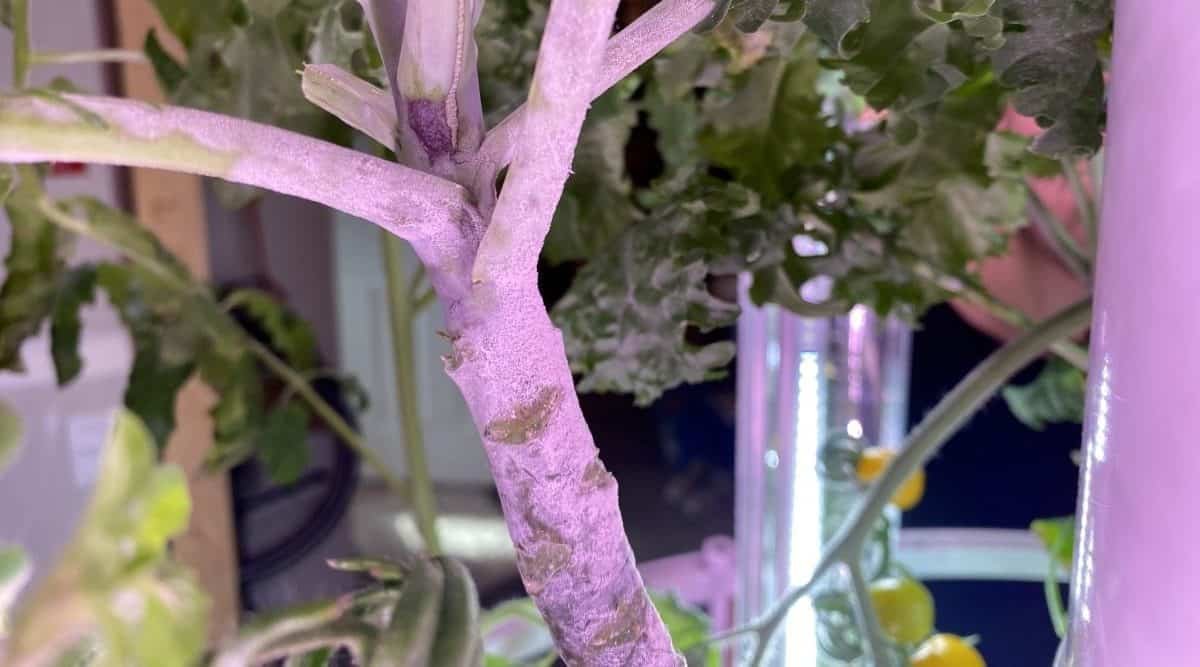
How to treat Powdery Mildew
There are several methods for treating powdery mildew. These may need to be applied several times to cure the outbreak.
Baking Soda – This is the most common treatment but is most effective when mixed with liquid soap and dormant oil. Use 1 tbsp baking soda, 1 tsp dormant oil, and 1 tsp liquid soap to 1 gallon of water and spray on the plants.
Potassium bicarbonate – Probably the most effective at killing powdery mildew. Mix with water according to package directions and spray on the plants.
Vinegar – The acetic acid in vinegar can help manage powdery mildew. Mix 2-3 tbsp apple cider vinegar with 1 gallon of water and spray on the plants.
| Preview | Product | |
|---|---|---|

|
All Seasons Horticultural Oil Spray Concentrate 32FL OZ | View Latest Deal |

|
Pure Original Ingredients Potassium Bicarbonate (1lb) Natural, Food Safe,... | View Latest Deal |
Gray Mold
Gray Mold is a fungus that can affect all plants. It usually attacks damaged or dying plants as it uses the nutrients found inside the plant to grow. It is identified by white or gray “mushy” or powdery spots on the plant.
It is most commonly found in cooler temperatures and high humidity. Gray Mold can easily spread from plant to plant.
How to treat Gray Mold
Unfortunately, the best way to deal with gray mold is to completely remove the infected plant from your hydroponic garden.
You can cut off infected leaves and fruit but you leave open cuts and wounds on the plant that make it more susceptible to gray mold. If you remove infected parts of the plant make sure to follow the section below on preventing disease so it doesn’t return.
When disposing of gray mold infected plants, place in a brown paper bag before disposing of it so it cannot spread to other areas of your garden.
Fungicides can also be used to control gray mold but are not necessary. PureCrop1 is an organic fungicide that can help control and eliminate gray mold.
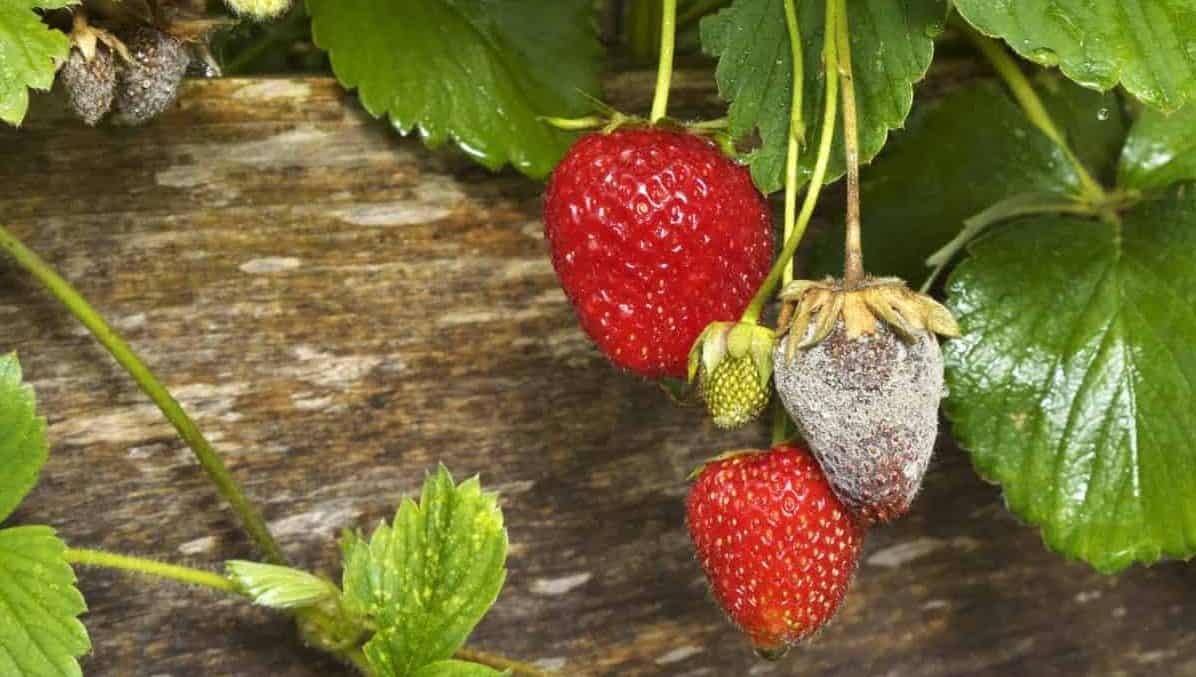
How to Prevent Disease in Hydroponics
The most common diseases in hydroponics gardens are caused by mold, mildew, or fungus. Fortunately, most diseases can be prevented by improving air circulation, controlling humidity, disinfecting tools, proper lighting, and general garden maintenance.
Improve Air Circulation
Proper air circulation reduces the chance of mold, mildew, or fungus spores settling on your hydroponic plants. When initially planning your garden, properly spacing your plants allows air to freely flow between them.
Pruning plants regularly lets air easily move not only between different plants but within the leaves and branches of the plant.
Adding ventilation and fans to indoor hydroponic systems will move air that would normally be stagnant. Fans can also be added to outdoor gardens if it is located in an area with low natural airflow.
- Designed to ventilate grow tents, transfer heating/cooling to rooms, circulate air, exhaust...
- Features a wired 10-speed fan controller; also compatible with all UIS controllers with...
- PWM-controlled EC motor provides quiet and energy-efficient performance with minimal heat and...
Control Humidity
High humidity is another factor that most plant diseases thrive in. In an indoor hydroponic system, humidity can be easily controlled with a good ventilation system or a dehumidifier.
In outdoor settings controlling the humidity is next to impossible. Your best option is to ensure there is adequate air circulation.
Disinfect Tools and Equipment
Tools and equipment should be disinfected after every use, sometimes even between plants. This is especially important for your pruning shears.
Cleaning your tools after using them will prevent bacteria and mold from growing on the plant residue which will then be transferred to your healthy plants the next time you use them.
It’s also a good idea to clean between pruning plants in different areas. This will stop diseases from being transferred from a sick plant to a healthy plant.
Vinegar is an effective disinfectant. Wiping your tools down with vinegar is a natural way to kill germs without using harsh chemicals.
Provide Adequate Lighting
You may not think lighting would be an issue, especially in an indoor hydroponic setup. But plants can get shaded by their tall, leafy neighbors.
It’s important to check for overly shaded areas that molds and funguses love. Pruning plants and ensuring proper spacing will help light reach all areas of your plant.
Adding more lighting to your system is another way to ensure all areas are getting the right amount of light required. Find out our top picks in our article, Hydroponic Lighting Requirements.
Hydroponic Garden Maintenance
Performing general maintenance in your hydroponic garden is an easy way to prevent disease from occurring. Removing plant cutting and keeping your garden clean will help prevent most funguses and molds.
If you do any misting or top watering with your plants, do it early in the day so the foliage and flowers have a chance to dry in the light.
Plant Leaf Issues in Hydroponics
Hydroponically grown plants rely on a water and nutrient balance to grow. This may lead to a few issues with leaf growth. The most common leaf issues can occur in all garden situations. Here are a few common hydroponic plant leaf issues and how to fix them.
Leaf Curling
Leaf curling is often caused by heat from temperatures indoors and outdoors, heat from lighting, or a nutrient imbalance. The direction the leaf curls is also an indication of what the issue is.
If the leaves are dark green and curled downward, overfeeding the plants could be your issue.
If the leaves curl upward, the plant is missing a vital nutrient or has been suffering from excess heat.
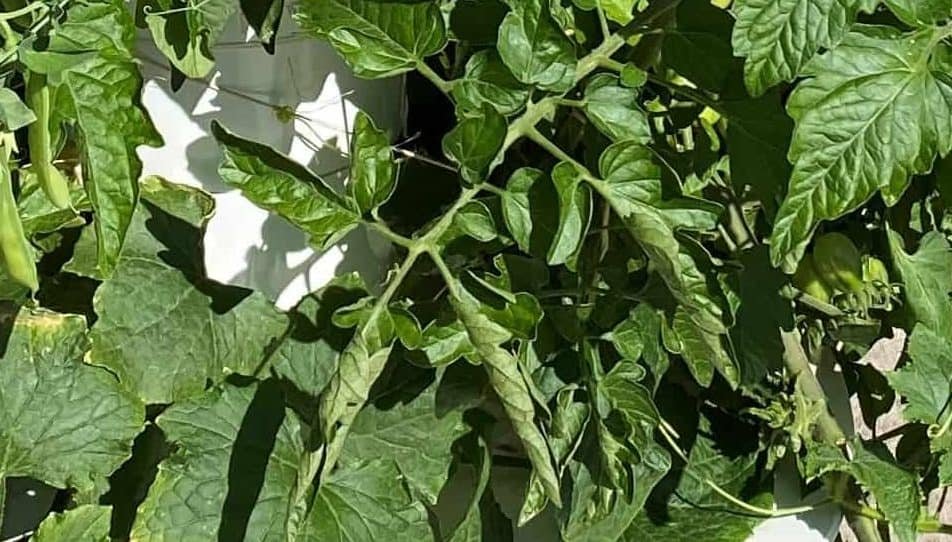
How to Fix Curled Leaves
Most of the time once a leaf curls, it will rarely uncurl. Many times a curled leaf will not affect the plant’s ability to bear fruit.
Different plants have different nutrient requirements and some are more sensitive to climate changes than others.
Overfeeding your plants can lead to downward leaf curl as the plant will try to expel excess water this way. Check that your hydroponic system isn’t cycling the water too often (depending on the type of set up you have. Reducing the nutrient to water ratio can help prevent leaf curl due to overfeeding.
With upward curled leaves, if there has recently been a heatwave or the plant was exposed to excessive direct sunlight, then the leaf curl may be caused by too much heat. There is little you can do in this case aside from keeping your nutrient solution cool and shading your plant from extreme sunlight.
Another reason for upward curled leaves is the plant is missing a vital nutrient. Consult your nutrient blend and the feeding requirements of your plant to determine what nutrient is lacking. Also, check the pH level of your solution.
If you need to change your nutrient blend, or even just add an additional mineral, you will need to look at your entire hydroponic system so all your plants are getting the right nutrients.
Leaf Changing Color
Leaf browning or changing color can be caused by a multitude of factors. There are also many different symptoms that are caused by different issues. I will cover some of the most common ones and how to fix them.
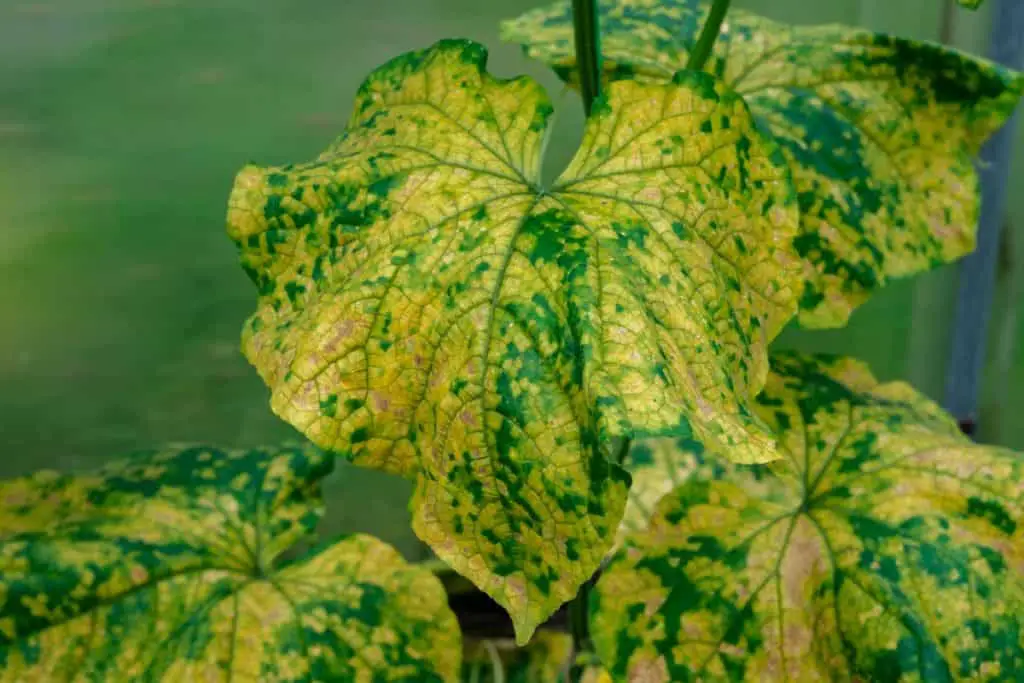
Browning Leaves
If the leaves are browning around the edge they may not be getting enough water or your nutrient solution may be too strong.
Check how the roots of your plants look and if they can properly reach the nutrient solutions. If they don’t seem to be properly covered adjust how the plant is sitting in the system. If this is occurring on multiple plants you may need to increase the systems water level.
Browning on the upper leaves of a plant is caused by overfeeding, nutrient toxicity, or salt build up. Adjust your nutrient solution and check the pH level. You may need to fully flush and clean your system.
Spots on Leaves
Spots on leaves can be caused by disease, pests, or root issues. Thoroughly inspect your plant for fungus and pests. If you notice either treat according to the sections above.
Check how the roots of your plants look. Healthy roots will be white while unhealthy roots will be brown. Also, check the pH of your solution as pH imbalance can lead to many issues.
If you are having trouble diagnosing your problem, start by flushing your nutrient solution and starting fresh.
You can also spray your plant down with a mixture of hydrogen peroxide, water, and a little castile soap. Use 100mL 70% alcohol, 400mL water, and 1 tsp of soap. This will help kill any pests on your plants.
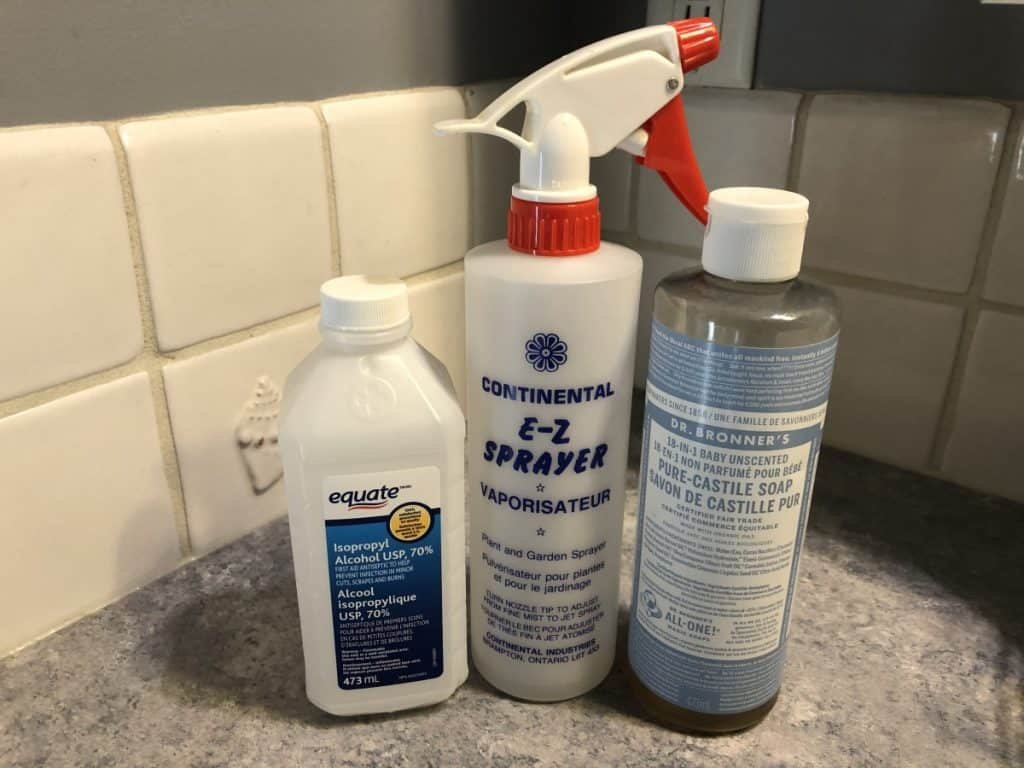
Yellowing of Leaves
Yellow leaves are usually the result of root issues. Check if your plant’s roots are healthy. If root rot is suspected then follow the treatment outlined in the root rot section.
pH imbalance is also a cause of yellowing leaves. Check your solution’s pH level and adjust it accordingly.
You should also check your lighting system. Too little or too much light can cause problems for your plants so ensure your system is providing the right amount of light.
Leaf Drooping
Leaf drooping is often caused by a lack of oxygen getting to the roots. This can lead to major issues like root rot. Another factor could be too much heat.
How to Fix Leaf Drooping
If your leaf droop is caused by a lack of oxygen, then adding an air stone and air pump to your system will help. You can also adjust your plant so half of the roots are exposed to air while the other half is in the nutrient solution.
If you suspect too much heat, start by monitoring the temperature around your plants. Check is several times a day while the lights are on if you have an indoor setup. Adding fans and ventilation will help reduce the heat if your plants are suffering from overheating.
You can also change the style of light you use to ones that produce little to no heat, like LEDs.
If your garden is outdoors, adding shade to your plants and improving air circulation are the best chance of reducing heat stress.
Common Pests in Hydroponics
Pests are a common occurrence indoors and outdoors. Here are some common hydroponic plant pests and how to prevent them.
- Aphids: Aphids are common indoors, in greenhouses, and outdoors. These little things are also called plant lice because they suck the juice out of your plants’ leaves and turn them yellow.
- Spider Mites: Spider Mites are also common indoors, in greenhouses, and outdoors. They are small (About 1mm long) and love to live on the underside of plants’ leaves. Look for webbing or take a tissue and wipe along the underside of your plant. If blood is on your tissue, you have a spider mite problem.
- Thrips: Common indoors, outdoors, and in greenhouses, thrips, like aphids, suck on leaves, leaving them brown with yellow spots on them.
- Fungus Gnats: Primarily an indoor pest, fungus gnats are not dangerous to plants. It is their larvae that are dangerous because they feed on roots.
- Whiteflies: Common to the indoors and greenhouses, Whiteflies compete with Spider Mites to feed on the undersides of plants. These pests look like small white moths.
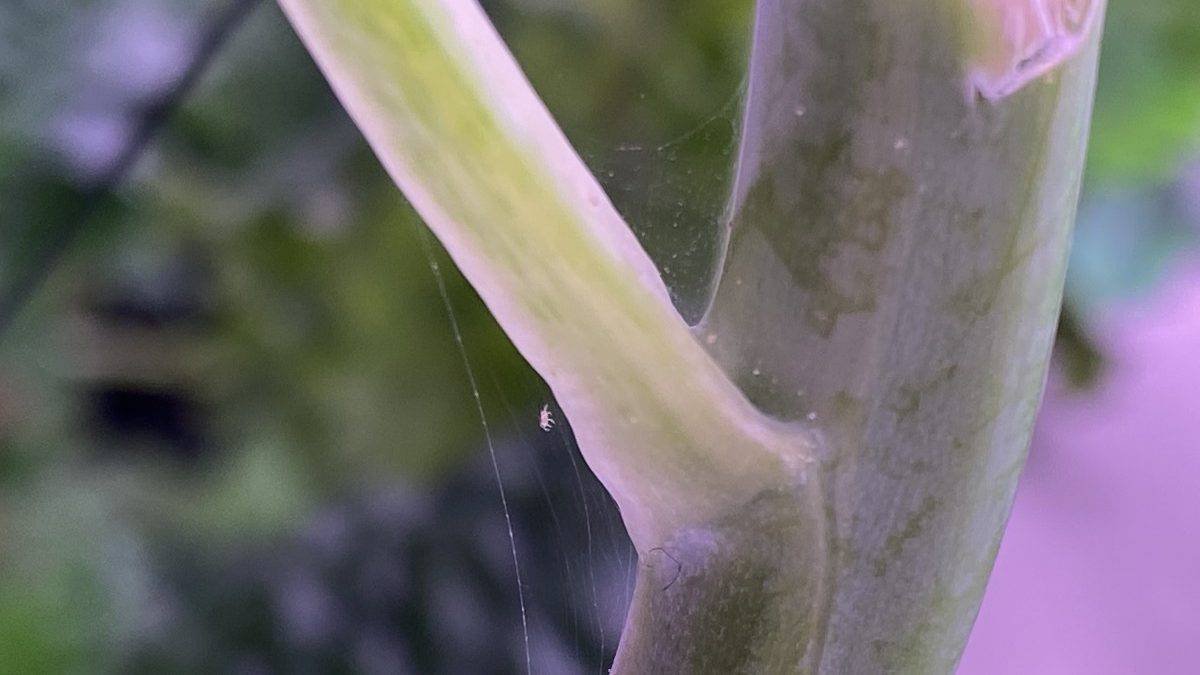
How to Treat and Prevent Pests from Investing Your Plants
- Sticky Traps: Different colored sticky traps are good for catching indoor pests. The different colors are for catching different pests since some pests like some colors more than others. Yellow sticky cards attract whiteflies. Blue cards attract thrips. Traps can be used to help stop an infestation before it starts.
- Being Clean and Sterile: When you enter your growing area, you should make sure you are as clean and sterile as possible. Pests, bacteria, and diseases can stick to your clothes and infect your plants from the simplest touch. Also cleaning up your garden area will reduce the chance of infestation.
- Spray Water: Spraying water on your plant won’t kill all the pests, but it can kill some and prevent reproduction.
- Make Your Own Pest Killer: Many pests don’t like Neem oil. Make a solution of Neem oil and water then spray down your plants. This can kill many common plants. Alternatively, a solution of 70% rubbing alcohol, water, and castile soap can be used as well.
- Pest Controlling Bugs: Bugs that are not dangerous to hydroponic plants, like Lacewings and Ladybugs, are another way to prevent pests from killing or harming your plants. Be careful in choosing which bug best gets rid of your pest problem. I wouldn’t recommend doing this for indoor plants.
- MULTIPLE SHAPE: We have different shapes and quantity for gnat killer, which can make your...
- YELLOW STICKY TRAP: Bright color attract flying insects, and high quality glue keeps them from...
- EASY TO USE: The fruit fly trap with sharp bottom can be inserted directly into the soil,...
Hydroponic Plant Growth Issues
Plant growth can be another common issue in hydroponic systems. This can include plants that simply aren’t growing. Or, maybe their growth has plateaued, and they’re not getting any bigger.
Many growing issues can be easily fixed by changing the lighting or the nutrient solution. But sometimes the culprit is your hydroponic setup or poor plant selection.
Poor Lighting
When your system is indoors, you need some type of grow lights that act as the sun. If you have insufficient lighting your plants will not grow healthy and strong.
Plants that aren’t receiving enough light will not grow properly. They may be short and stunted or may end up tall, skinny, and weak.
How to Fix Poor Lighting
Investing in high quality lights is the best solution for poor lighting. You may need to add more lights to your system and make sure there is enough space between the lights and your plants to grow.
You also need to make sure you have the right light spectrum. Fruiting and flowering plants have different requirements than green, leafy plants. Read more in our article Hydroponic Lighting Requirments.
Insufficient Water Supply
Lack of water is another common reason that plants don’t grow properly. You might assume in a hydroponic system insufficient water supply will not be an issue.
But if your reservoir is low or your system wasn’t set up properly you might run into this issue. Leaks are another concern you should watch for especially if your system is older or recently set up. Joints are the biggest culprits for leaks if they aren’t connected properly.
How to Fix Water Supply Issues
First, inspect your system for leaks. Before you add more water to your system you’ll want to ensure you don’t have water leaking out of your system. If a leak is found, fix it!
Then check your reservoir level, it could simply be your water level is too low for water to flow properly to your plants. Once your reservoir level is topped up make sure the water is flowing properly (if that is the type of system you have) and the roots of your plants can reach the water.
Insufficient or Excess Nutrients
Improper nutrients are one of the main reasons for plant growth issues in all types of gardening. Having either too much or too little of a nutrient can cause numerous issues.
It’s important to have the proper nutrient blend for the plants you are growing. Green, leafy plants, like lettuce, have different nutrient requirements than fruiting and flowering plants, like tomatoes.
Nutrient solutions will have three numbers on the front in the format N-P-K, where N is nitrogen, P is potassium and K is phosphorus. This is the ratio of nitrogen, potassium, and phosphorus in the solution.
Nutrient solutions with higher potassium and phosphorus are better for fruiting and flowering plants. Solutions higher in nitrogen are better for leafy plants. All plants need these major nutrients to grow.
How to Fix Nutrient Issues
Using a high quality nutrient solution is a good place to start with your hydroponic garden. Each garden will have different nutrient needs depending on the plants in it. Read more about the top hydroponic nutrient solutions in our article.
The issues you are seeing in your plant and what plants you are growing will affect what nutrients you need to increase or decrease.
Too much nitrogen will cause poor root growth and lack of flowers while too little nitrogen will result in small plants.
Too much potassium will inhibit other nutrient absorption and lead to poor disease resistance while too little potassium will lead to poor root and shoot development.
Too much phosphorus will lead to extensive root growth and stunted plants while too little phosphorus will lead to poor root growth and a lack of flowers and fruit.
Plants aren’t bearing Fruit
There are two main culprits for plants not bearing fruit, these are nutrient issues or pollination issues.
If your plants aren’t flowering at all then it is likely a nutrient issue which I covered in the previous section. Generally, you need a nutrient solution higher in potassium and phosphorus for fruiting and flowering plants.
If your plants are flowering but not bearing fruit or bearing stunted malformed fruit it is likely a pollination issue.
How to Fix Fruit Bearing Issues
To fix a fruit bearing issue first you should make sure you have the proper nutrient solution to promote flowering in your plants. Use a solution that is higher in potassium and phosphorus.
For plants that are flowering but not fruiting, you will need to hand pollinate. In an outdoor setting bees, insects, and wind all contribute to pollination. They take pollen from a male flower and transport it to a female flower causing fruit to be produced.
In an indoor setting, you will have to do the pollinating yourself. You also need to make sure the plants you are growing produce both male and female flowers or have both male and female parts in the flower otherwise you will need a plant of each sex.
Plants like tomatoes, peppers, and strawberries are more or less self pollinating needing just a little wind or movement. You can gently shake the plant to move the pollen around.
Sometimes, especially with strawberries, you will get malformed fruit, which means the flower was not properly pollinated. You can gently brush from the outside edge of the flower to the center to help pollinate.
Plants like cucumber will need to be manually pollinated. Pollen from a male flower needs to be transferred to the female flower in order for the fruit to grow.
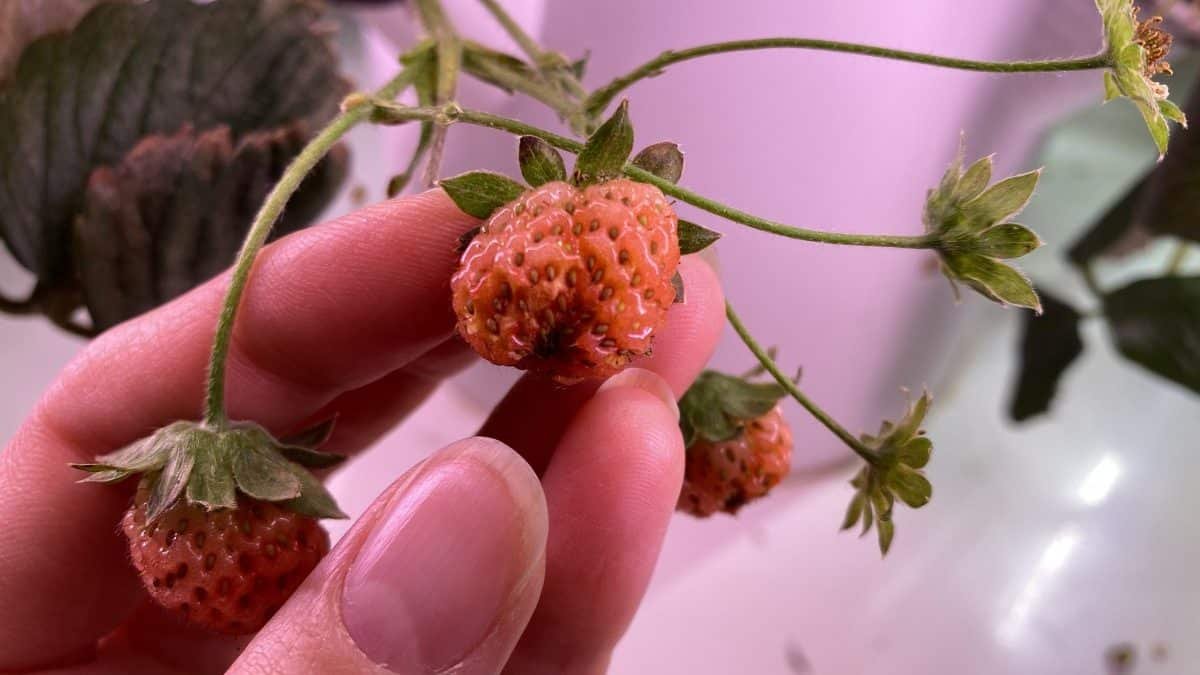
Poor Plant Selection for Hydroponics
Some plants are better than others for hydroponics. If your plants aren’t thriving in your hydroponic garden, and you’ve tried just about everything to get them to grow, they may be just not meant for hydroponics.
Root vegetables are extremely difficult if not impossible to grow in hydroponics. If plant selection is your problem then unfortunately the only way to solve it is by starting over. Check out my list of easy plants to grow in hydroponics for plants you know will succeed.
Final Thoughts
Hydroponic systems aren’t exempt from plant problems. They are still susceptible to pests, disease, and other growth issues.
However, compared to soil gardens, problems can be easier to diagnose and treat since you have access to the roots of your plants and can easily change the nutrients being provided to your plants.
By carefully monitoring and maintaining your hydroponic garden you can hopefully prevent most problems before they start.




